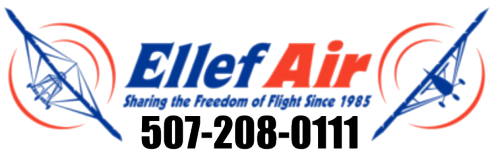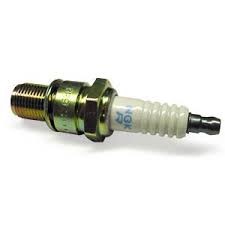Rotax Bing 54 Carburator Tuning and Troubleshooting
Your rotax two stroke engine won't start and the spark plugs are dry.
Dry spark plugs usually can be traced to fuel not getting to the carb, a plugged low speed jet, or the use of throttle when using the choke system. So find out why fuel isn't reaching the carb - e.g. - turn the fuel on - clean the low speed jet -
When using the choke system the throttles MUST BE AT THE IDLE POSITION - the choke does not work if the throttle is even cracked a small amount.
In order to do the following properly you should have an EGT gauge correctly installed with probes for each cylinder and a tachometer.
Rotax Two Stroke Engine starts but won't idle.
You don't have the slides in the carbs set correctly - refer to Tech tips 1 for the proper way to set up the slides. The low speed jet is plugged - clean it. Your low speed airscrew is adjusted incorrectly - refer to the Bing carb jet chart for proper airscrew setting .
This air screw changes the air/fuel mixture by changing the ratio of air to the idle jet circuit. Turning the screw out with lean the mixture while turning it in richens it. After referring to the jet chart you have a position to start from.
With the engine warmed up and idling and the screw set to factory specs turn the screw out very slowly - the engine should start to pick up rpm as you lean the mixture out. If nothing happens the low speed jet is probably plugged, or the small atomizer hole located in the throat of the carb on the engine side is blocked.
Once you have the engine idling at its highest and leanest setting using the air screw turn the screw back in 1/8 of a turn which will richen it up just enough for the best performance.
Note it is usually necessary to do this three or four times a year, do to the difference in air that you get in spring/summer/fall/winter.
Note that on the 582 Rotax I have found that 45 and 50 idle jet work better than the standard 55 especially in winter. On the 582 the lower jet sizes have been shown to improve starting and help eliminate the rough idle. Also setting the idle RPM to 2250 makes for a smoother idle.
A quick way of checking your mixture is to let the engine idle for a few minutes and then apply a burst of throttle. If the engine bogs it usually means your mixture is too lean. You can verify this by applying throttle then choke - which richens the mixture of course if the bog goes away then you have too lean of a mixture.
You can also change the mixture using the needle and clip - but remember this changes everything from idle to 3/4 throttle. Raising the clip - thus lowering the needle leans the mixture - while lowering the clip and raising the needle richens it.
Rotax Engine RPM varies at and idle - won't remain steady.
This is usually caused by an air leak. A failed intake manifold gasket. A crack in the intake manifold. If you have had the intake manifold off, the gaskets can fall down inside the cover. If you have had the cylinders off and don't use the proper alignment bar during reinstallation you can crack the intake manifold. A failed rubber O ring in the top of the carb cover plate. The rubber stopper covering the primer inlet has failed or is missing. Water in the bottom of the float bowl.
Engine sputter or misfires (0 - 1/8 throttle)
This area is controlled by the low speed or idle jet, and air mixture screw. Check to make sure the jet is clean and the proper size. Check to see the air mixture screw is set correctly.
Engine sputter or misfires (1/8 - 1/2 throttle)
This generally indicates a lean fuel mixture. Check to make sure your needle and clip are in the right position and are not damaged. The air screw still has some effect here.
Engine sputter or misfires (1/2 - 3/4 throttle)
This area is controlled by the needle jet and jet needle. Verify that you have the correct jet and needle jet. Also verify that they are located BELOW the white plastic retaining cup. If they are located on top of the retainer the engine will run rough in all ranges, since the mixture is wrong in all locations.
The mid range is controlled by the needle and needle jet. The needle jets are available in various sizes with the larger numbers giving a richer fuel mixture and the lower numbers a leaner mixture.
A reported problem with ALL Bing 54 carbs used on Rotax Aircraft Engines is with failure of the jet needle and or needle clip.
This can result in erratic running, lean fuel mixtures, engine returning to and idle during flight.
To determine whether you need to adjust the needle jets you require a EGT gauge and tachometer.
For example:
Many owners of 582's have reported high EGT readings in the 5600 to 5800 rpm range using the stock needle jet of 272 - using a 274 or 276 eliminates this problem.
Owners of older model 532 report having a problem keeping the engine set at 5400 rpm. It would jump up and down from 5400 to 5800 resulting from a lean fuel mixture.
Again the larger jet usually cures this problem.
Engine sputter or misfires (3/4 to full throttle)
This area is controlled by the main jet. Check to make sure it is in place and snug. Make sure there is no water in the bottom of the float bowl. Make sure the needle and clip are in good working condition. If the needle fails around the clip retaining area this will allow the needle to jump up and down causing erratic running. Proper float level is also important here to little fuel flow can cause an lean mixture while to must flow can result in a rich mixture.
One area that is of concern is in higher altitudes and colder climates. Higher altitudes usually require leaner fuel settings - lower size main jets, while colder temperatures require increased jet sizes to compensate for the thicker air.
Consult the Bing jet chart for proper jet recommendations.
Now if you are tuning your carb using the above these have to be present!
1. The engine has to be in good working order.
2. The engine has to have the proper prop load.
3. The engine, carb jetting, exhaust etc all have to be STOCK, as supplied or recommended from the factory or knowledgeable/authorized person.








